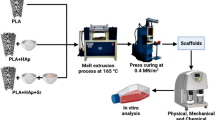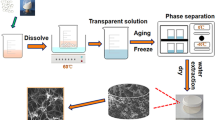Abstract
A novel synthetic method to synthesize hydroxyapatite/poly (D,L) lactic acid biocomposite is presented in this study by mixing only the precursors hydroxyapatite and (D,L) LA monomer without adding neither solvent nor catalyst. Three compositions were successfully synthesized with the weight ratios of 1/1, 1/3, and 3/5 (hydroxyapatite/(D,L) lactic acid), and the grafting efficiency of poly (D,L) lactic acid on hydroxyapatite surface reaches up to 84 %. Scanning electron microscopy and Fourier transform infrared spectroscopy showed that the hydroxyapatite particles were successfully incorporated into the poly (D,L) lactic acid polymer and X ray diffraction analysis showed that hydroxyapatite preserved its crystallinity after poly (D,L) lactic acid grafting. Differential scanning calorimetry shows that Tg of hydroxyapatite/poly (D,L) lactic acid composite is less than Tg of pure poly (D,L) lactic acid, which facilitates the shaping of the composite obtained. The addition of poly (D,L) lactic acid improves the adsorption properties of hydroxyapatite for fibronectin extracellular matrix protein. Furthermore, the presence of poly (D,L) lactic acid on hydroxyapatite surface coated with fibronectin enhanced pre-osteoblast STRO-1 adhesion and cell spreading. These results show the promising potential of hydroxyapatite/poly (D,L) lactic acid composite as a bone substitute material for orthopedic applications and bone tissue engineering.







Similar content being viewed by others
References
Aboudzadeh N, Imani M, Shokrgozar MA, Khavandi A, Javadpour J, Shafieyan Y, Farokhi M. Fabrication and characterization of poly(D,L-lactide-co-glycolide)/hydroxyapatite nanocomposite scaffolds for bone tissue regeneration. J Biomed Mater Res Part A. 2010;94A:137–45.
Rezwan K, Chen QZ, Blaker JJ, Boccaccini AR. Biodegradable and bioactive porous polymer/inorganic composite scaffolds for bone tissue engineering. Biomaterials. 2006;27:3413–31.
Kim SS, Park MS, Jeon O, Choi CY, Kim BS. Poly(lactide-co-glycolide)/hydroxyapatite composite scaffolds for bone tissue engineering. Biomaterials. 2006;27:1399–409.
Zhang PB, Hong ZK, Yu T, Chen XS, Jing XB. In vivo mineralization and osteogenesis of nanocomposite scaffold of poly (lactide-co-glycolide) and hydroxyapatite surface-grafted with poly(L-lactide). Biomaterials. 2009;30:58–70.
Zhang RY, Ma PX. Biomimetic polymer/apatite composite scaffolds for mineralized tissue engineering. Macromol Biosci. 2004;4:100–11.
Cui Y, Liu Y, Cui Y, Jing X, Zhang P, Chen X. The nanocomposite scaffold of poly(lactide-co-glycolide) and hydroxyapatite surface-grafted with L-lactic acid oligomer for bone repair. Acta Biomater. 2009;5:2680–92.
Yang Z, Jiang Y, Yu LX, Wen B, Li F, Sun S, Hou T. Preparation and characterization of magnesium doped hydroxyapatite–gelatin nanocomposite. J Mater Chem. 2005;15:1807–11.
Itoh S, Kikuchi M, Koyama Y, Takakuda K, Shinomiya K, Tanaka J. Development of an artificial vertebral body using a novel biomaterial, hydroxyapatite/collagen composite. Biomaterials. 2002;23:3919–26.
Chang JH, Park ME, Shin Y, Exarhos GJ, Kim KJ, Lee SC, Oh KS. Functional scaffolds of bicontinuous, thermoresponsive L-3-phase silica/hydroxyapatite nanocomposites. J Mater Chem. 2007;17:238–42.
Wei G, Ma PX. Structure and properties of nano-hydroxyapatite/polymer composite scaffolds for bone tissue engineering. Biomaterials. 2004;25:4749–57.
Wei JC, Liu AX, Chen L, Zhang PB, Chen XS, Jing XB. The surface modification of hydroxyapatite nanoparticles by the ring opening polymerization of γ-benzyl-L-glutamate N-carboxyanhydride. Macromol Biosci. 2009;9:631–8.
Murugan R, Ramakrishna S. Bioresorbable composite bone paste using poly-saccharide based nano hydroxyapatite. Biomaterials. 2004;25:3829–35.
Nair LS, Laurencin CT. Biodegradable polymers as biomaterials. Prog Polym Sci. 2007;32:762–98.
Martina M, Hutmacher DW. Biodegradable polymers applied in tissue engineering research: a review. Polym Int. 2007;56:145–57.
Hong Z, Zhang P, He C, Qiu X, Liu A, Chen L, Chen X, Jing X. Nano-composite of poly(L-lactide) and surface grafted hydroxyapatite: mechanical properties and biocompatibility. Biomaterials. 2005;26:6296–304.
Shikinami Y, Okuno M. Bioresorbable devices made of forged composites of hydroxyapatite (HA) particles and poly L-lactide (PLLA). Part II: practical properties of miniscrews and miniplates. Biomaterials. 2001;22:3197–211.
Kim S, Kim SS, Lee SH, Eun Ahn S, Gwak SJ, Song JH, Kim BS, Chung HM. In vivo bone formation from human embryonic stem cell-derived osteogenic cells in poly(d,l-lactic-co-glycolic acid)/hydroxyapatite composite scaffolds. Biomaterials. 2008;29:1043–53.
Singh R, Singh S, Lillard JW. Past, present, and future technologies for oral delivery of therapeutic proteins. J Pharm Sci. 2008;97:2497–523.
Sinha VR, Bansal K, Kaushik R, Kumria R, Trehan A. Poly-epsilon-caprolactone microspheres and nanospheres: an overview. Int J Pharm. 2004;278:1–23.
Kannan RM, Perumal O, Kannan S. Cellular interactions of nano drug delivery systems. In: Force microscopy: Applications in biology and medicine In: Jena B P, Hacker J K, editors. Hoerber John Wiley & Sons; 2006. pp. 113–36.
Vert M, Christel P, Garreau H, Audion M, Chanavaz M, Chabot F. Totally bioresorbable composites systems for internal fixation of bone fractures. Polym Sci Technol. 1986;34:263–75.
Vert M, Li SM, Spenlehauer G, Guerin P. Bioresorbability and biocompatibility of aliphatic polyesters. J Mater Sci Mater Med. 1992;3:432–46.
Therin M, Christel P, Li S, Garreau H, Vert M. In vivo degradation of massive poly(α-hydroxy acids): validation of in vitro findings. Biomaterials. 1992;13:594–600.
Neuendorf RE, Saiz E, Tomsia AP, Ritchie RO. Adhesion between biodegradable polymers and hydroxyapatite: relevance to synthetic bone-like materials and tissue engineering scaffolds. Acta Biomater. 2008;4:1288–96.
Hong ZK, Qiu XY, Sun JR, Deng MX, Chen XS, Jing XB. Grafting polymerization of l-lactide on the surface of hydroxyapatite nano-crystals. Polymer. 2004;45:6699–706.
Qiu X, Chen L, Hu J, Sun J, Hong Z, Liu A, Chen X, Jing X. Surface-modified hydroxyapatite linked by L-lactic acid oligomer in the absence of catalyst. J Polym Sci, part A Polym Chem. 2005;43:5177–85.
Qiu X, Hong Z, Hu J, Chen L, Chen X, Jing X. Hydroxyapatite surface modified by L-lactic acid and its subsequent grafting polymerization of L-lactide. Biomacromolecules. 2005;6:1193–9.
Andrade JD. In surface and interfacial aspects of biomedical polymers: protein adsorption. New York: Plenum press; 1985. pp. 1–80.
Norde W. Adsorption of proteins at solid-liquid interfaces. Cells Mat. 1995;5:97–112.
Puleo DA, Nanci A. Understanding and controlling the bone-implant interface. Biomaterials. 1999;20:2311–21.
Ducheyne P, Qiu Q. Bioactive ceramics: the effect of surface reactivity on bone formation and bone cell function. Biomaterials. 1999;20:2287–303.
El-Ghannam A, Ducheyne P, Shapiro IM. Effect of serum proteins on osteoblast adhesion to surface-modified bioactive glass and hydroxyapatite. J Orthop Res. 1999;17:340–5.
Villarreal DR, Sogal A, Ong JL. Protein adsorption and osteoblast responses to different calcium phosphate surfaces. J Oral Implantol. 1998;24:67–73.
Dee KC, Puelo DA, Bizios R. Protein-Surface interactions. In: an introduction to tissue-biomaterial intercations. New York: John Wiley & Sons, Inc; 2002. pp. 37-52.
Gugutkov D, Altankov G, Hernandez JCR, Pradas MM, Sanchez MS. Fibronectin activity on substrates with controlled -OH density. J Biomed Materials Res A. 2010;92A(1):322–31.
Dolatshahi-Pirouz A, Jensen T, Foss M, Chevallier J, Besenbacher F. Enhanced surface activation of fibronectin upon adsorption on hydroxyapatite. Langmuir. 2009;25:2971–8.
Bennett JS, Berger BW, Billings PC. The structure and function of platelet integrins. J Thromb Haemos. 2009;7:200–5.
Nakanishi K, Sakiyama T, Imamura K. On the adsorption of proteins on solid surfaces, a common but very complicated phenomenon. J Biosci Bioeng. 2001;91:233–44.
Palin E, Liu H, Webster TJ. Mimicking the nanofeatures of bone increases bone-forming cell adhesion and proliferation. Nanotechnology. 2005;16:1828–35.
Yala S, Khireddine H, Sidane D, Ziani S, Bir F. Surface modification of natural and synthetic hydroxyapatites powders by grafting polypyrrole. J Mater Sci. 2013;48:7215–23.
Poulouin L, Gallet O, Rouahi M, Imhoff JM. Plasma fibronectin: three steps to purification and stability. Protein Expr Purif. 1999;17:146–52.
Oyajobi BO, Lomri A, Hott M, Marie PJ. Isolation and characterization of human clonogenic osteoblast progenitors immunoselected from fetal bone marrow stroma using STRO-1 monoclonal antibody. J Bone Miner Res. 1999;14:351–61.
Sidane D, Chicot D, Yala S, Ziani S, Khireddine H, Iost A, Decoopman X. Study of the mechanical behavior and corrosion resistance of hydroxyapatite sol-gel thin coatings on 316L stainless steel pre-coated with titania film. Thin Solid Films. 2015;593:71–80.
Sidane D, Khireddine H, Yala S, Ziani S, Bir F, Chicot D. Morphological and mechanical properties of hydroxyapatite bilayer coatings deposited on 316L SS by sol-gel method. Metall Mater Trans B. 2015;46B:2340–7.
Zheng X, Zhou S, Yu X, Li X, Feng B, Qu S, Weng J. Effect of in vitro degradation of poly(D,L-lactide)/β-tricalcium composite on its shape-memory properties. J Biomed Mater Res B Appl Biomater. 2008;86:170–80.
Hong JL, Hyung WC, Kyung JK, Sang CL. Modification on hydroxyapatite nanosurfaces for enhanced colloidal stability and improved interfacial adhesion in nanocomposites. Chem Mater. 2006;18:5111–18.
Shan H, Zhang Z. Preparation of nanometer-sized ZrO2/Al2O3 powders by heterogeneous azeotropic distillation. J Eur Ceram Soc. 1997;17:713–17.
Sharp JS, Forrest JA, Jones RA. Surface denaturation and amyloid fibril formation of insulin at model lipid-water interfaces. Biochem. 2002;41:15810–19.
Engel M, Mierlo CV, Visser A. Kinetic and structural characterization of adsorption-induced unfolding of bovine α-lactalbumin. J Biol Chem. 2002;277:10922–30.
Kim J, Somorjai GA. Molecular packing of lysozyme, fibrinogen, and bovine serum albumin on hydrophilic and hydrophobic surfaces studied by infrared−visible sum frequency generation and fluorescence microscopy. J Am Chem Soc. 2003;125:3150–8.
Kondo A, Fukuda H. Effects of adsorption conditions on kinetics of protein adsorption and conformational changes at ultrafine silica particles. J Colloid and Interface Sci. 1998;198:34–41.
Kondo A, Mihara J. Comparison of adsorption and conformation of hemoglobin and myoglobin on various inorganic ultrafine particles. J Colloid and Interface Sci. 1996;177:214–21.
Pellenc D, Berry H, Gallet O. Adsorption-induced fibronectin aggregation and fibrillogenesis. J Colloid and Interface Sci. 2006;298:132–44.
Persson M, Lorite GS, Kokkonen HE, Cho SW, Lehenkari PP, Skrifvarsc M, Tuukkanen J. Effect of bioactive extruded PLA/HA composite films on focal adhesion formation of preosteoblastic cells. J colloid surface B. 2014;121:409–16.
Arnett T. Regulation of bone cell function by acid-base balance. Proc Nutr Soc. 2003;62:511–20.
Sui G, Yang X, Mei F, Hu X, Chen G, Deng X, Ryu S. poly L-lactic acid/hydroxyapatite hybrid membrane for bone tissue regeneration. J Biomed Mater Res A. 2007;82(2):445–54.
Costa DO, Prowse PD, Chrones T, Sims SM, Hamilton DW, Rizkalla AS, Dixon SJ. The differential regulation of osteoblast and osteoclast activity by surface topography of hydroxyapatite coatings. Biomaterials. 2013;34:7215–26.
Teti A. Bone development: overview of bone cells and signaling. Curr Osteoporos Rep. 2011;9:264–73.
Arnett TR. Acidosis, hypoxia and bone. Arch Biochem Biophys. 2010;503:103–9.
Acknowledgments
The authors thank F.VIDAL and S.ALFONSI (LPPI, Cergy-Pontoise University, Cergy-Pontoise, France) for use of the hydraulic press
Author information
Authors and Affiliations
Corresponding author
Ethics declarations
Conflict of interest
The authors declare that they have no competing interests.
Rights and permissions
About this article
Cite this article
Yala, S., Boustta, M., Gallet, O. et al. New synthesis method of HA/P(D,L)LA composites: study of fibronectin adsorption and their effects in osteoblastic behavior for bone tissue engineering. J Mater Sci: Mater Med 27, 140 (2016). https://doi.org/10.1007/s10856-016-5756-8
Received:
Accepted:
Published:
DOI: https://doi.org/10.1007/s10856-016-5756-8




